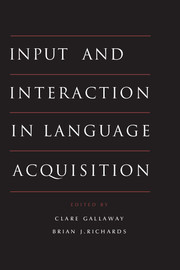Book contents
- Frontmatter
- Contents
- List of figures
- List of tables
- List of contributors
- Preface
- Introduction
- Beginning from Baby Talk: twenty years of research on input in interaction
- Part I General issues
- Part II Specific aspects of input and interaction
- Part III Types of language learner
- Conclusion
- References
- Author index
- Subject index
Beginning from Baby Talk: twenty years of research on input in interaction
Published online by Cambridge University Press: 05 June 2012
- Frontmatter
- Contents
- List of figures
- List of tables
- List of contributors
- Preface
- Introduction
- Beginning from Baby Talk: twenty years of research on input in interaction
- Part I General issues
- Part II Specific aspects of input and interaction
- Part III Types of language learner
- Conclusion
- References
- Author index
- Subject index
Summary
Introduction
Research on the nature of linguistic input to language-learning children has a longer history than “modern” child language research (the era whose beginning I take to be marked by the publication of Brown and Bellugi 1964). Anthropological linguists and fieldworkers were publishing papers in the 1950s and 1960s about the phenomenon of “Baby Talk” as a special register of the languages they had studied. They documented Baby Talk primarily as an interesting sociolinguistic phenomenon, but often reported as well the local beliefs that it aided children in learning to talk. Even in the earliest moments of the “modern era” of child language research, analyses of input were never ignored. For example, Brown and Bellugi identified “expansion,” a maternal response, as one of the three processes involved in language acquisition in their 1964 work.
Despite this early and consistent interest, the accumulation of information about the nature of adult speech to language-learning children was fairly slow until the mid 1970s. During the 1970s and 1980s, in contrast, the amount of work on interaction expanded enormously. There have been dozens of papers on this topic published in the Journal of Child Language since its inception in 1974, as well as in the journal First Language. At least half of the papers selected for publication in conference volumes following each of the last three meetings of the International Association for the Study of Child Language (held in 1984 in Austin, Texas, in 1987 in Lund, Sweden, and in 1990 in Budapest, Hungary) have been devoted to studies of input and interaction.
- Type
- Chapter
- Information
- Input and Interaction in Language Acquisition , pp. 3 - 12Publisher: Cambridge University PressPrint publication year: 1994
- 51
- Cited by



